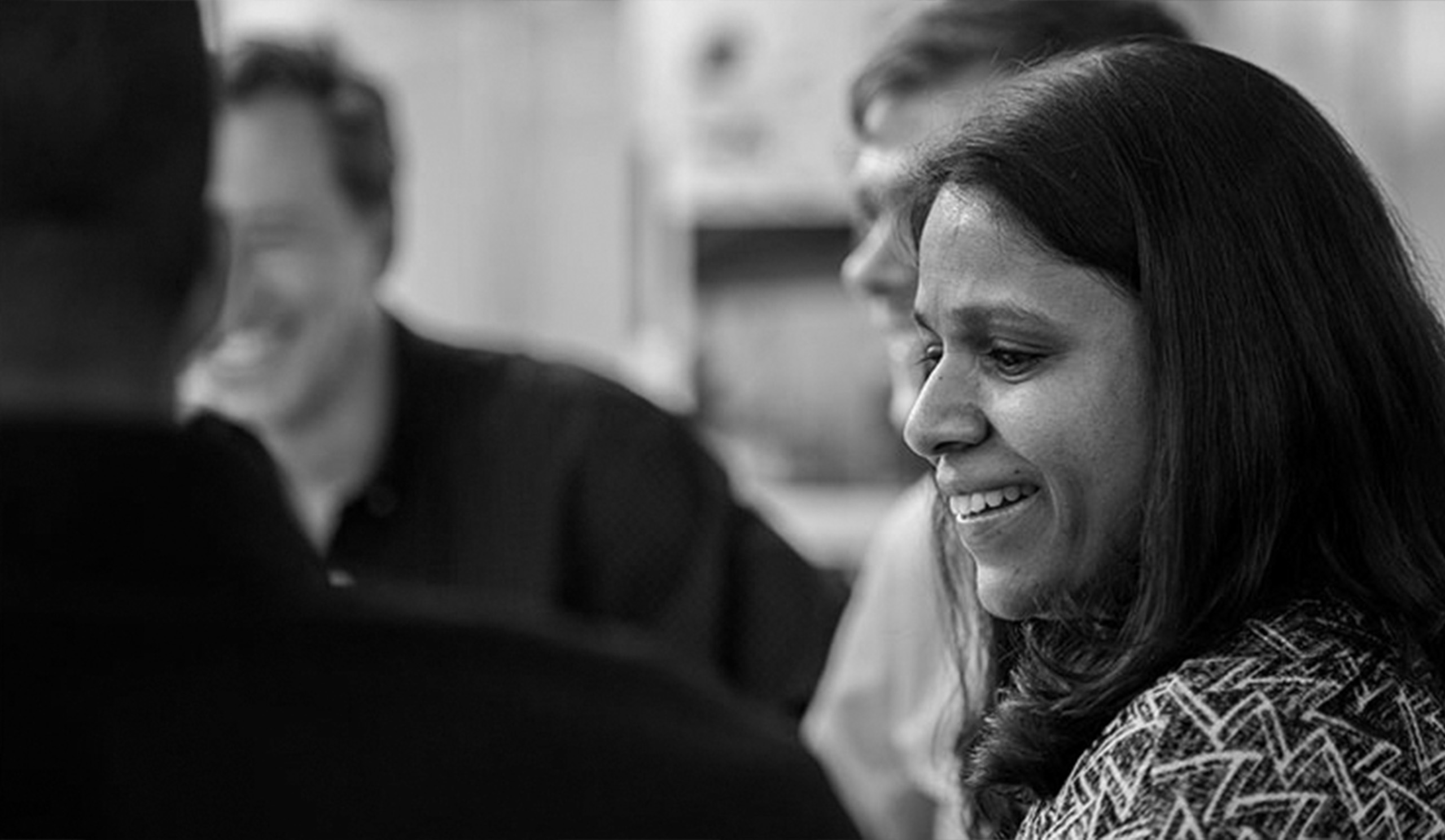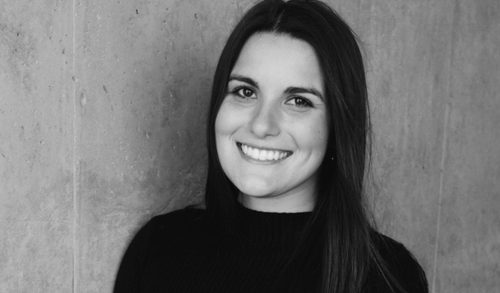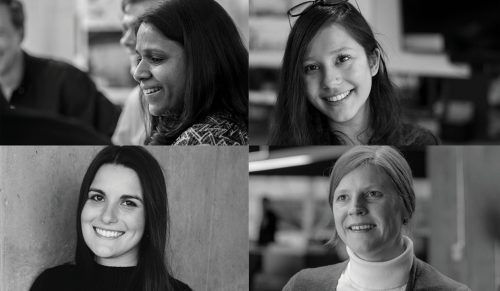
Inspiring Design: Interviews with BNIM Women in Design – Part 1
In our daily work, we often look to our colleagues and collaborators as we seek out and share inspiration. Our team members at BNIM approach our work with collective care, each bringing expertise, talents, and passions to create the best outcomes and a better practice. As we honor Women’s History Month this March, we are excited to share the stories from several individuals at BNIM who inspire and energize our firm each day. In this Inspiring Design series, we connect with Beena Ramaswami, Hannah Gray, Fiona Bhuyan, and Katie Nichols to learn more about their pathways to architecture and design, their thoughts on the future of design, and how their work is positively transforming our communities, environment, and profession.
Beena Ramaswami, Associate Principal + Director of Brand Identity
Beena is BNIM’s Director of Brand Identity who brings three decades of architecture, design, and communications experience to her work. She leads the conceptualization and design of print and digital collateral that advance BNIM’s brand, overseeing a wide range of initiatives including publication design, project photography and media, and website design. Beena is a thought leader and mentor within the firm, supporting teams across BNIM and elevating our practice through her collaborative approach and passion for architecture.
“Design excellence for me is the exquisite embodiment of the least amount of carbon and the most amount of heart – a deep acknowledgement of land and labor working towards the betterment of the human, natural, and built environments.”
What first inspired you to enter the architecture and design field?
BR: I remember having a vintage IKEA catalog at home as a child. My father, an engineer, designed and drew furniture that would be made by local woodworkers at home in India. Design was part of my growing up.
My mother’s father was a doctor, and I was his first grandchild. He was grooming me to be a doctor, and if anybody had asked me as a child what I wanted to be when I grew up, I would have said a doctor. So, I applied for medical school and even had an interview.
When I was in twelfth grade, one of my friend’s sisters was working on her architecture thesis. There were these big drawings, rolls of paper, study models, what have you, strewn around her room that were so beautiful and inspiring. At the time, I was still planning to study medicine, but made a complete flip at the last minute and decided to pursue architecture!
As Director of Brand Identity at BNIM, you lead a wide spectrum of initiatives, from graphic design for signage and wayfinding on projects to BNIM’s brand to media relations, project photography, print and digital communications. Can you share more about your path from architecture to graphic design and brand identity?
BR:This is interesting because architecture is such a great foundational design education. You are trained to find solutions to the ‘wicked problem’ – one that solves for interconnectivity and reality in the world. It is not one plus one equals two. Instead, an architectural education gives you a broad way to go about any project at hand.
I was a practicing architect for about a third of my career, and I worked on many interesting projects. During that time, I also began to explore an independent design practice, and in 1998, I designed and developed my first website with a friend from architecture school – my first real penchant for using technology in my work and experiencing remote work. I valued the type of flexibility the combination gave me and saw the need for graphic design and communications work at architecture firms, who at the time rarely had in-house studios. Moving away from being a practicing architect was a practical, personal decision for me.
Understanding the work of architects and especially BNIM intimately, I was, with the trusting support of my colleagues, able to explore various mediums and initiatives that helped to convey the identity, work and larger purpose of the firm and its talented people. While architecture is my passion, I am lucky to have built a space for allied work within the larger field of architecture.
How do environmental graphics contribute to creating spaces that elevate human experience?
BR:Environmental graphics at BNIM are designed to be integrated into and support the architectural experience. They take on various roles from providing safety, orientation, and prospect, to creating an identity, inspiraton, and a sense of place so all users are equitably served in a building. For instance, at the Pacific Center Campus buildings, they relayed a sense of wellness and place through the abstraction of native plants and the natural environments in San Diego. At the University of Missouri-Columbia’s Patient-Centered Care Learning Center, the graphics, through the work of the University’s photography department, helped illustrate a sense of empathy by people across the state.
What are some of the projects or initiatives you have worked on in your career that have been most impactful to you?
BR:Three book projects come to mind. My first project with BNIM, the NIST [National Institute for Standards and Technology] Report was the design of a book illustrating the work of Bob Berkebile, Jason McLennan, Phaedra Svec and others. The report served as a precursor to LEED and changed how we approach sustainability.
The second book was called FLOW, the making of the Omega Center, which was a flip book illustrating the making of the building and the Living Building Challenge measures designed by Steve McDowell and Laura Lesniewski. The Omega Center was the first LEED Platinum and Living Building in the world.
And the newest is the ALL book, which I think was impactful at so many levels. The book was a companion piece to the making of the Tom and Ruth Harkin Center (designed by Kevin Nordmeyer, Jason Kruse, and others) enumerating strategies for inclusive design. The process of making the book was a mindful collaboration with Natalie Gaydar and Emily Herndon that helped create a framework for their individual areas of expertise.

Has your outlook and approach to design evolved over time? What most inspires and motivates you in your work now?
BR: There was a time when I had a two-dimensional approach to design, even though we visualized in perspectives, studied skiagraphy, and made models. It was formal and a thing of beauty with some attention to the sun and land. Things needed to be just so, to be formally perfect.
Later, I understood systems thinking and the connection between human, natural, and built systems. Even through such a systematic approach, it seemed like our work was only output focused. It was all about the final product and how it would affect and live in the world.
With the pandemic came a renewed awareness of the other side of things – the human worker. The embodied labor of workers from every profession – architects, client team members, consultants, contractors, plumbers, electricians, construction workers – cannot be ignored in design and the people they serve.
Design excellence for me now is the exquisite embodiment of the least amount of carbon and the most amount of heart – a deep acknowledgement of land and labor working towards the betterment of the human, natural, and built environments.
BNIM has always been at the forefront of new thinking in architecture and design, and its people are full of heart and optimism working to create a better world. Every day, I am inspired and motivated by my colleagues, and the supportive environment that fosters continual growth and improvement.
What are your hopes for the future of the architecture and design profession?
BR: Design is a labor of love, and it needs to be an act of care for the planet, place, land, flora, fauna, and all humans. In a world preoccupied with the role of AI in the future of design, and its effect on labor, equity and diversity, my hope is that architects and designers will rise again to solve another wicked problem.

